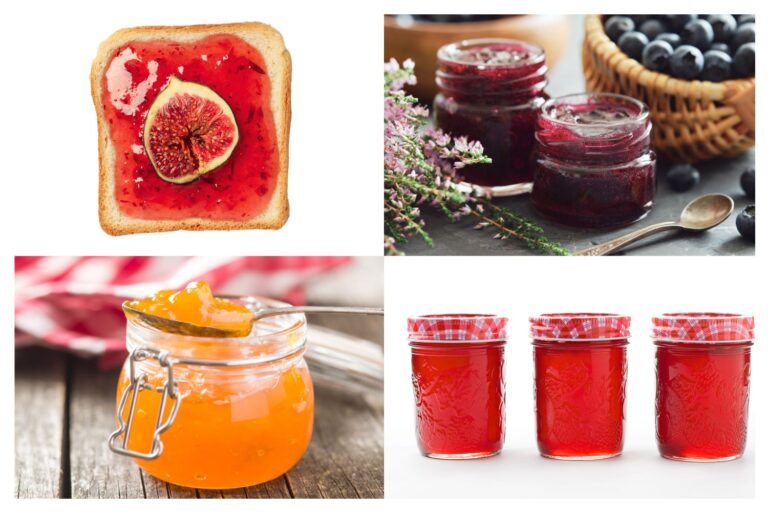Does that old jar of jelly in your fridge have you wondering, “Does jelly go bad?”
It goes great on everything from sandwiches to cookies. But as with any food product, it doesn’t last forever.
Does Jelly Go Bad?
The quick answer is: yes, it can!
Jelly has a relatively long shelf life because of its high sugar content, which acts as a natural preservative. However, storing your jelly incorrectly and time can lead to spoilage, affecting its texture, taste, and safety.
So how do you know when it’s time to toss your jelly?
In this guide, we’ll cover everything you need to know about how to know if your jelly has gone bad, long jelly lasts, how to store it properly, and signs that it has gone bad.
We’ll also cover how you should store your jelly, so it stays fresh as long as possible.
What is Jelly Exactly?
According to the National Center for Home Food Preservation at the University of Georgia:
“Jelly, jam, preserves, conserves and marmalades are fruit products that are jellied or thickened. Most are preserved by sugar….. They have long been used as a traditional method for preserving seasonal fruits, effectively prolonging their shelf life while encapsulating the vibrant essence of fresh, ripe flavors. “
How to Tell If Your Jelly Has Gone Bad
Jelly doesn’t spoil easily, but it doesn’t last forever.
Here are clear signs it’s not safe to eat:
1. Mold Growth
If you spot fuzzy, green, white, or black mold on the surface of your jelly, discard it immediately. Even scraping off the mold does not make it safe—spores can spread throughout the jar.
2. Sour Smell
Fresh jelly has a sweet, fruity aroma. If it smells sour, fermented, or rancid, it’s most likely bad.
3. Texture Changes
Jelly should have a smooth, gel-like consistency. If it turns watery, grainy, or clumpy, it may have deteriorated because of temperature fluctuations or bacterial growth.
4. Discoloration
Color changes or dark spots suggest exposure to air, light, or contamination. These are signs it’s best to toss the jelly.
5. Unusual Taste
If the jelly tastes strange, bitter, or overly fermented, it has likely gone bad—even if there’s no visible mold.
How Long Does Jelly Last?
The shelf life of jelly depends on whether it is opened or unopened, its ingredients, and how it’s stored.
Unopened Jelly
- Commercially packaged jelly is safe for 6 months to 1 year at room temperature.
- Some varieties with preservatives can last even longer, but quality may decline with age.
- Always check the expiration or “best by” date for guidance.
Opened Jelly
- Once opened, jelly should be refrigerated to maintain freshness.
- Properly stored opened jars last 1 to 3 months, depending on sugar content and preservatives.
- Sugar-free or low-sugar jelly typically has a shorter shelf life because of reduced preservative action.
What About Homemade Jelly?
- Homemade jelly (without commercial preservatives) lasts around 1 month in the refrigerator.
- Sealed, properly canned homemade jelly can stay fresh for 6 months to a year.
Proper Jelly Storage: How to Keep It Fresh
To extend the shelf life of jelly and prevent spoilage, follow these storage tips:
- Keep unopened jelly in a cool, dry place like a pantry or cupboard.
- Refrigerate opened jelly to maintain texture and prevent bacteria growth.
- Use a clean utensil when scooping jelly to avoid cross-contamination.
- Seal the lid tightly to prevent moisture and bacteria from entering.
- Avoid sunlight and humidity, which can alter its consistency and quality.
Frequently Asked Questions
Can you eat expired jelly?
Jelly past its best by date is often still safe if it shows no signs of spoilage. However, its taste and texture may degrade.
Does sugar-free jelly go bad faster?
Yes. Sugar is a natural preservative, so low-sugar or sugar-free jelly is more prone to spoilage.
Can mold in jelly make you sick?
Absolutely. Mold can produce toxins that lead to digestive issues or illness, so it’s best to throw it away.
Is homemade jelly safer than store-bought jelly?
Homemade jelly contains fewer preservatives, so it expires faster. However, properly sealed it can last several months.
Conclusion
While jelly has a long shelf life thanks to its high sugar content, it can go bad over time, especially when exposed to moisture, air, and bacteria.
Refrigeration and proper storage help maximize freshness.
Always check for mold, off odors, or unusual texture before consuming.
If you’re ever unsure if it’s bad, it’s better to be safe and throw it out!
Further Reading
Do You Need to Refrigerate Jelly?
Does BBQ Sauce Need to Be Refrigerated?
Does Ketchup Go Bad? Everything You Need to Know.
Should Mustard Be Refrigerated?
Does Peanut Butter Go Bad?
Should Soy Sauce Be Refrigerated?
Should Honey Be Refrigerated?
Better Living uses affiliate links. If you make a purchase through them, we may receive a small commission (for which we are deeply grateful) at no cost to you.



